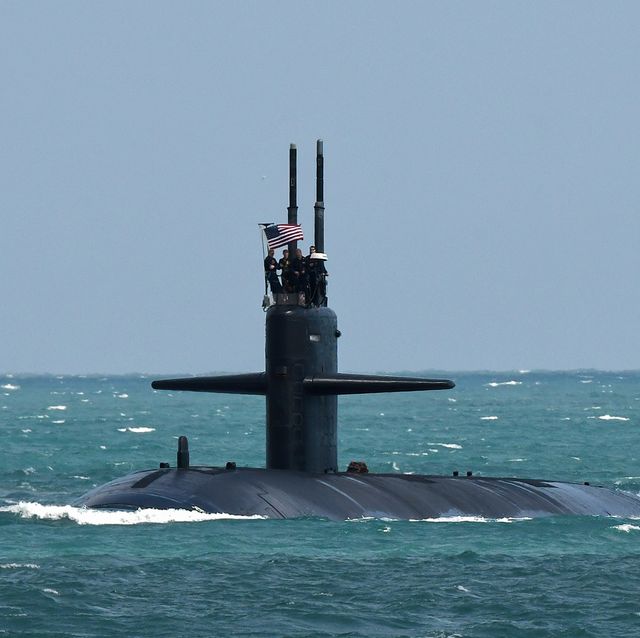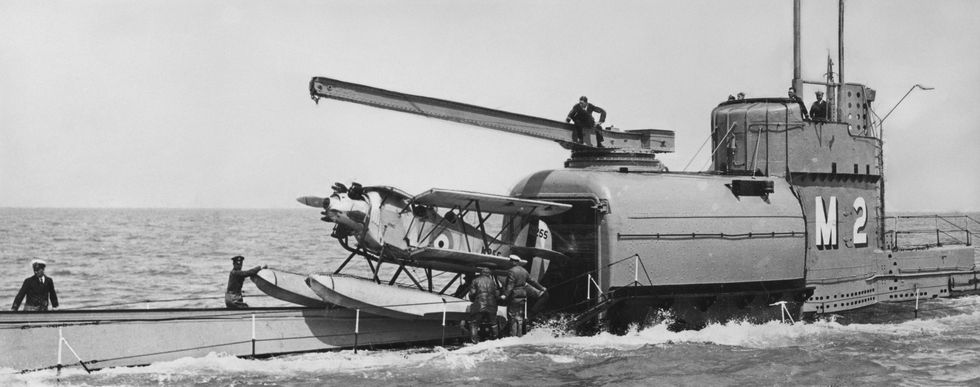KYLE MIZOKAMI

This new capability addresses the traditionally poor situational awareness of the submarine.
It’s hard to know what’s going on when you’re underwater. For more than 100 years, submarines have struggled with a lack of situational awareness—the result of being low to the surface of the ocean or underneath it. Now, thanks to the drone revolution, submarines will have access to flying cameras, giving them their own eyes in the sky.
The World Through a Periscope

U.S. Navy
A naval officer looks through the periscope of the attack submarine USS Springfield in Busan, Republic of Korea, February 2023.
Submarines use their ability to dive underwater to ambush targets, lying in wait for a hostile warship, cargo ship, or oiler to pass by before firing a salvo of torpedoes or missiles. Submarines typically detect their targets by passively listening for the sound of movement through a technique called passive sonar, and collecting the target’s electronic signals, like outgoing radar and communications traffic. This information can allow a sub to know the speed, heading, alert status, and identity of the enemy ship—all without actually seeing it.
A submarine’s options for visually detecting and inspecting targets (or simple objects of interest) is very limited. A sub is close to the surface of the water, and a periscope has a detection distance of about 12 miles or less. It’s a highly restricted field of view, and unlike ships like frigates, destroyers, and aircraft carriers, a submarine cannot launch a helicopter or other aircraft to visually check something out. That is, until now.
Submarines don’t have their own aircraft, but they do have a means for placing small drones in the water. Subs are typically equipped with a submarine signal ejector, a device that has traditionally allowed submarines to discharge signal flares into the surrounding water for communication with ships and airplanes.
The Naval Undersea Warfare Center (NUWC) of Newport, Rhode Island has procured a drone that can fit in a signal ejector. Once discharged, the Submarine Launched Unmanned Aerial System (SLUAS), otherwise known as the AeroVironment Blackwing, rises to the surface of the water and shoots out from its launch canister, taking flight. The drone is then controlled by the crew of the submarines. The drone uses a datalink to beam electro-optical signals, a digital camera operating in the infrared band, back to an antenna in the submarine’s periscope mast.

AeroVironment
The Blackwing drone.
Blackwing is three inches wide (the diameter of the signal ejector tube), 19 inches long, and has a wingspan of 27 inches, and weighs just four pounds. The drone uses a push propeller for propulsion, but the NUWC, in an October post, did not mention how long or fast it could fly. NUWC also does not call the drone by its commercial name, Blackwing, but continues to call it SLUAS.
SLUAS is currently deployed with the fleet, and in 2021 a report stated the Navy was buying 120 of the drones. In December 2023, the Commander of Submarine Group 7, Rear Adm. Chris Cavanaugh, and Japan Maritime Self Defense Force Rear Admiral Yoshihiro Goka met on the USS Santa Fe, where the American admiral oversaw a SLUAS demonstration for his Japanese counterpart. The article mentions that SLUAS/Blackwing has a “beyond line of sight” capability, meaning it can operate over the horizon from the sub that launched it, giving it a range of at least 12–13 miles.
Why Stop There?

Getty Images
Navies have long experimented with combining submarines and aviation. HMS M2 was converted in 1927 to launch and recover seaplanes. The lack of a crew and other modern technologies means drones can be made much smaller and less of a hassle to launch.
Blackwing may be the first submarine-operated aerial drone, but it won’t be the last. Again and again, drones first evolve as surveillance platforms, then attack platforms. One possibility is submarines of the future built with a larger signal ejector tube, more like a drone ejector tube, that could accommodate a drone with a high explosive payload. That could allow a submarine to deal with smaller ships, like high-speed sub chasers, without expending a full-size torpedo.
At a certain point, submarines could start looking like underwater aircraft carriers.
The next level of evolution would be larger, higher performance drones, perhaps even drones that could attack ships from the air or shoot down other drones or manned aircraft. Where this ride stops nobody knows, but at a certain point, submarines could start looking like underwater aircraft carriers.
Equipping submarines to operate unmanned aircraft is not without risk. The submarine must rise to periscope depth to communicate with the drone, and in the process of launching drones, the sub could be discovered by submarine hunters. This could be solved by launching drones from a greater distance to the target, but the question is whether or not the sub can effectively communicate with a drone at longer ranges.
The Takeaway
SLUAS/Blackwing represents a major new capability for the Navy, and it will be interesting to see where the service ultimately takes it. Is a drone capability beyond SLUAS more risky to a $2 billion submarine than it’s worth, or are more sophisticated drones simply a capability too good to pass up? In future years, we might see Blackwing as a tentative step, just like the first flight of an airplane from a ship.
No comments:
Post a Comment